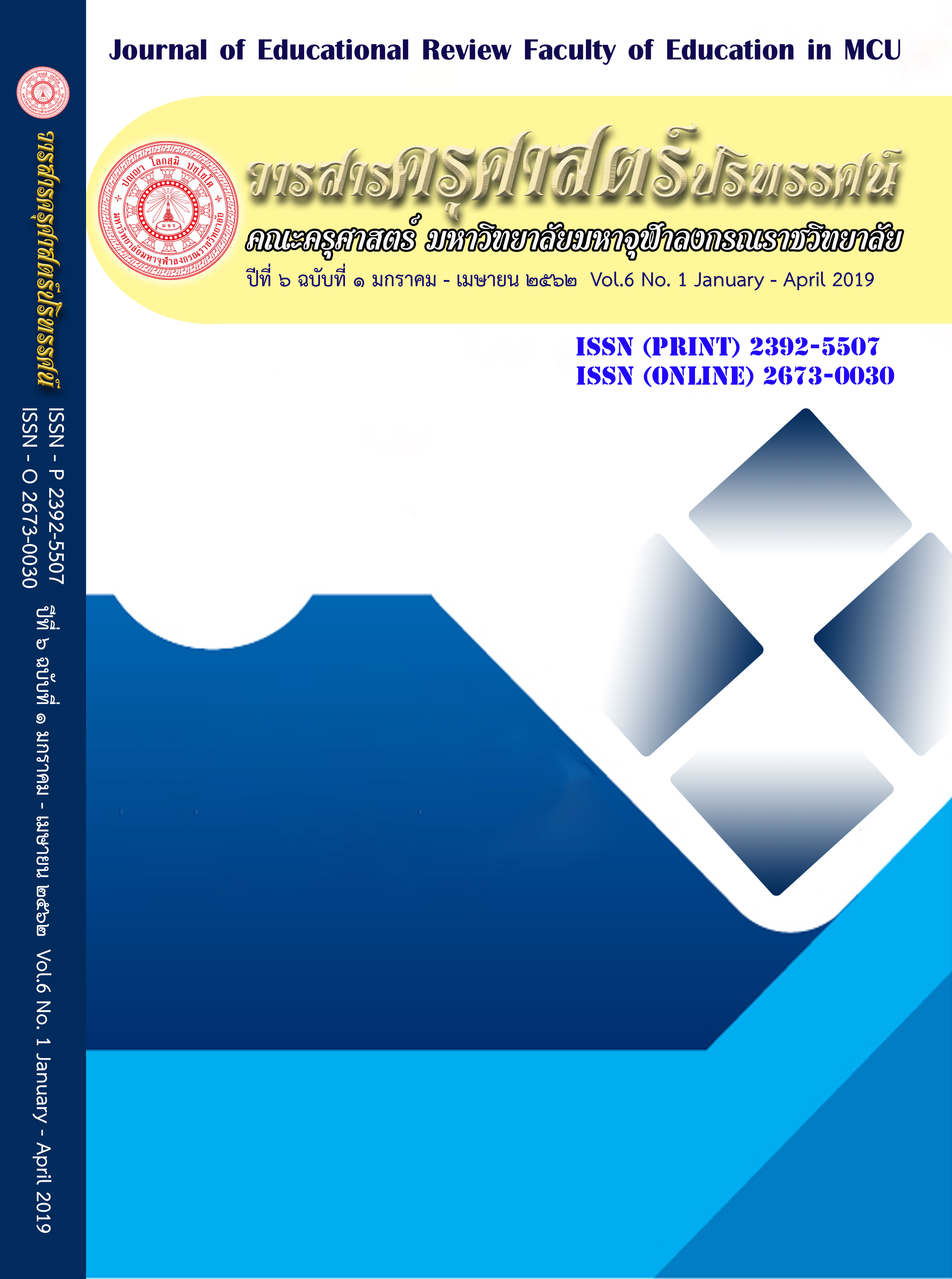A Guideline for Learning and Teaching Management on Science Subject in Accordance With the 5 Bahusutta in School Network 49 Under Klongsamwa District Office, Bangkok
Main Article Content
Abstract
This research aims: 1) to study the teaching of science subjects in school network 49 in Klongsamwa District of Bangkok, 2) to study the teaching of science in accordance with Bahusutta Principles, and 3) to propose a guideline for teaching of science in accordance with Bahusutta Principles. This qualitative research is comprised of document analysis, in-depth interviews with 6 key-informants teaching science in primary schools, and group discussions with 6 experts. The data were analyzed by content analysis and frequency.
The research results found that:
- The conditions of teaching and learning science subjects in school network 49 in Klongsamwa District of Bangkok indicated that; 1) Course contents were excessive to learners’ ability, attitude and enthusiasm in the subject, 2) The teaching process should be adjusted to suite the leaners, 3) There was limitation of instructional media, instrument and equipment used in experimental activities, 4) The activity based teaching could affect the lesson plan since the teachers had no enough experiences in this teaching method, and 5) There were variety of tools used in measurement and evaluation that could improve the effectiveness of teaching and learning.
- The teaching of science in accordance with Bahusutta Principles in course content, learning process, media, instrument and evaluation was in concordance with Vacasa Paricita the most, and teaching activity was in concordance with Manasanupekkhita the most.
- The guideline for teaching of science in accordance with Bahusutta Principles was that; 1) In Bahussuta, students learn from the real life experience, learn by questions and answers and improve their listening skill, 2) In Dhata, the data are classified systematically to facilitate the learners in searching and recollection, 3) In Vacasa Paricita, the management in teaching and learning process, environment and learning resources is to facilitate teaching and learning, and relate to time table, learning class levels, and course contents based on learner-centered teaching, 4) In Manasanupakkhita, students have channels to express their opinions, give suggestions and ask questions. The schools supply instructional media and technology relevant to learning process, have network for teaching and learning exchange, and arrange self-learning system, and 5) In Ditthiya Supatividdha, the administration on curriculum, environment, learning resources, and measurement and evaluation was relevant to maturity, skills and attitude of the learners
Article Details
ทัศนะและความคิดเห็นที่ปรากฏในบทความในวารสารฉบับนี้ถือเป็นความรับผิดชอบของผู้เขียนบทความนั้นเพียงผู้เดียว และไม่ถือเป็นทัศนะและความรับผิดชอบของกองบรรณาธิการ
กองบรรณาธิการขอสงวนสิทธิ์ในการคัดเลือกบทความลงตีพิมพ์และจะแจ้งให้เจ้าของบทความทราบหลังจากผู้ประเมินบทความตรวจอ่านบทความแล้ว
ต้นฉบับที่ได้รับการตีพิมพ์ในวารสารครุศาสตร์ปริทรรศน์ คณะครุศาสตร์ มหาวิทยาลัยมหาจุฬาลงกรณราชวิทยาลัย ถือเป็นกรรมสิทธิ์ของคณะครุศาสตร์ มหาวิทยาลัยมหาจุฬาลงกรณราชวิทยาลัย ห้ามนำข้อความทั้งหมดหรือบางส่วนไปพิมพ์ซ้ำ เว้นเสียแต่ว่าจะได้รับอนุญาตจากมหาวิทยาลัยฯ เป็นลายลักษณ์อักษร
References
คณะกรรมการการศึกษาแห่งชาติ, สำนักงาน. (๒๕๕๓). พระราชบัญญัติการศึกษาแห่งชาติ พ.ศ. ๒๕๔๒ แก้ไขเพิ่มเติม(ฉบับที่ ๒) พ.ศ. ๒๕๔๕ . กรุงเทพมหานคร : พริกหวานกราฟฟิค.
จำเนียร กิ่งแก้ว. ผลของการสอนแบบอริยสัจสี่ที่มีต่อความสามารถในการคิดอย่างมีวิจารณญาณและผลสัมฤทธิ์ทางการเรียน เรื่อง หลักธรรมทางพระพุทธศาสนา ของนักเรียนชั้นประถมศึกษาปีที่ ๖ โรงเรียนบ้านป่าข่า จังหวัดอุบลราชธานี. วิทยานิพนธ์ศึกษาศาสตร์มหาบัณฑิต. บัณฑิตวิทยาลัย : มหาวิทยาลัยสุโขทัยธรรมาธิราช.
นักเรียนชั้นประถมศึกษาปีที่ ๖ โรงเรียนวัดกู่คำ อำเภอสันปาตอง จังหวัดเชียงใหม่. วิทยานิพนธ์ครุศาสตรมหาบัณฑิต. บัณฑิตวิทยาลัย : มหาวิทยาลัยราชภัฏเชียงใหม่.
พระครูโสภณธรรมประดิษฐ์ (วีระพัฒน์ จันทร์ศรีนาค). (๒๕๕๕). การศึกษาผลสัมฤทธิ์ทางการเรียนและเจตคติต่อการเรียนสาระพระพุทธศาสนา กลุ่มสาระการเรียนรู้สังคมศึกษา ศาสนาและวัฒนธรรมที่จัดการเรียนรู้ตามแนวอริยสัจสี่ ของนักเรียนชั้นประถมศึกษาปีที่ ๖. วิทยานิพนธ์ครุศาสตรมหาบัณฑิต. บัณฑิตวิทยาลัย : มหาวิทยาลัยราชภัฏนครศรีธรรมราช.
พระปัญญาวรวัฒน์ สิริภทฺโท. (๒๕๕๕). ความขัดแย้งของสังคมไทยกับการแก้ปัญหาตามแนวทางอริยสัจ ๔. วารสารบัณฑิตศึกษาปริทรรศน์. ปีที่ ๘ ฉบับพิเศษ เนื่องในโอกาสเฉลิมฉลองพุทธชยันตี ๒๖๐๐ ปี แห่งการตรัสรู้ของพระพุทธเจ้า (๑ มิถุนายน ๒๕๕๕) : ๒๑๕ – ๒๑๖.
พระพรหมคุณาภรณ์ (ป.อ. ปยุตฺโต). (๒๕๕๖). ความสำคัญของพระพุทธศาสนา ในฐานะศาสนาประจำชาติ. พิมพ์ครั้งที่ ๑๙. กรุงเทพมหานคร : ธรรมสภาและสถาบันบันลือธรรม.
พระพรหมคุณาภรณ์ (ป.อ. ปยุตฺโต). (๒๕๔๙). พุทธธรรม ฉบับปรับปรุงและขยายความ. พิมพ์ครั้งที่ ๑๑. กรุงเทพมหานคร : สหธรรมิก.
เพ็ญศิริ ภูมิสายดร กัญญารัตน์ โคจร และ กานต์สิริ ปักเคธาติ. (๒๕๕๘). การเปรียบเทียบผลสัมฤทธิ์ทางการเรียน การคิดแก้ปัญหาอย่างสร้างสรรค์ และเจตคติต่อวิทยาศาสตร์ ของนักเรียนชั้นประถมศึกษาปีที่ ๖ ระหว่างการจัดกิจกรรมการเรียนรู้แบบอริยสัจ ๔ และการจัดกิจกรรมการเรียนรู้แบบ CIPPA. วารสารศึกษาศาสตร์ มหาวิทยาลัยมหาสารคาม. ปีที่ ๙ ฉบับพิเศษ (เมษายน ๒๕๕๘) : ๕๐๒.
ราตรี รัตโนภาส สิน งามประโคน และระวิง เรืองสังข์. “การศึกษาการดำเนินงานโรงเรียนวิถีพุทธในจังหวัดพระนครศรีอยุธยา”. วารสารครุศาสตร์ปริทรรศน์. ปีที่ ๔ ฉบับที่ ๒ (พฤษภาคม – สิงหาคม ๒๕๖๐) : ๑๑๖.


